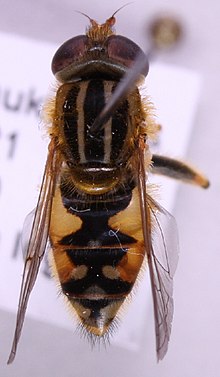Parhelophilus consimilis
Parhelophilus consimilis is a Palearctic hoverfly.[1][2]
| Parhelophilus consimilis | |
|---|---|
 | |
| Scientific classification | |
| Kingdom: | |
| Phylum: | |
| Class: | |
| Order: | |
| Family: | |
| Subfamily: | |
| Tribe: | |
| Genus: | |
| Species: | P. consimilis |
| Binomial name | |
| Parhelophilus consimilis (Malm, 1863) | |
Description
External images
For terms see Morphology of Diptera
Wing length 7 ·5-8 ·5 mm Apical 1/4 of front tibiae black. Tergite 1 with 2 diagonal dust bands. Face in lateral view protruding beyond frons. Reemer (2000) figures the male genitalia.[3]
See references for determination.[4][5][6][7]
Distribution
Palearctic Fennoscandia South to Belgium and North France. Ireland East through Britain, Denmark, Poland and North Europe and Russia to eastern Siberia.[8][9]
Biology
Habitat: Wetland. Fen, transition mire, bog, raised bog and cut-over bog.[10] Flowers visited include white umbellifers, Bidens cernua, Menyanthes, Potentilla palustris, Ranunculus.[11] Flies mid June to beginning August.[10]
gollark: At some point you may just run into fundamental value differences.
gollark: Yes, you can't get an "ought" from an "is" as some philosopher said.
gollark: > naw just regular ones, old cryogenics experiment from the forties* Nazis from the secret nazi moonbase
gollark: I'm beginning to wonder if I have too many open tabs/windows.
gollark: Which is true of ~every group.
References
- Stubbs, Alan E.; Falk, Steven J (1983). British Hoverflies: An Illustrated Identification Guide (2nd ed.). London: British Entomological and Natural History Society. pp. 253, xvpp. ISBN 1-899935-03-7.
- Ball, S.G.; Morris, R.K.A. (2000). Provisional atlas of British hoverflies (Diptera, Syrphidae). Monks Wood, UK: Biological Record Centre. pp. 167 pages. ISBN 1-870393-54-6.
- Reemer, M. (2000) A new species of Parhelophilus Girschner, 1897 (Diptera, Syrphidae) from southwestern Europe. Dipteron, 3: 1-6.
- Van Veen, M. (2004) Hoverflies of Northwest Europe: identification keys to the Syrphidae. 256pp. KNNV Publishing, Utrecht.addendum
- Van der Goot,V.S. (1981) De zweefvliegen van Noordwest - Europa en Europees Rusland, in het bijzonder van de Benelux. KNNV, Uitgave no.32: 275pp. Amsterdam.
- Bei-Bienko, G.Y. & Steyskal, G.C. (1988) Keys to the Insects of the European Part of the USSR, Volume V: Diptera and Siphonaptera, Part I. Amerind Publishing Co., New Delhi. ISBN 81-205-0080-6.
- Coe, R.L. (1953) Diptera: Syrphidae. Handbks.ident.Br.insects, 10(1): 1-98. R.ent.Soc.London. pdf
- Fauna Europaea
- Peck, L.V. (1988) Syrphidae. In: Soos, A. & Papp, L. (eds.) Catalogue of Palaearctic Diptera, 8: 11-230. Akad.Kiado, Budapest.
- Speight, M.C.D. (2011). "Species accounts of European Syrphidae (Diptera)" (PDF). Syrph the Net, the database of European Syrphidae. 65: 285pp.
- de Buck, N. (1990) Bloembezoek en bestuivingsecologie van Zweefvliegen (Diptera, Syrphidae) in het bijzonder voor België. Doc.Trav. IRSNB, no.60, 1-167.
This article is issued from Wikipedia. The text is licensed under Creative Commons - Attribution - Sharealike. Additional terms may apply for the media files.